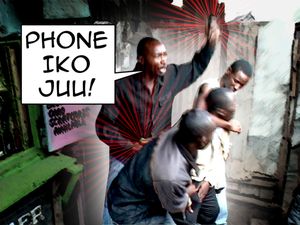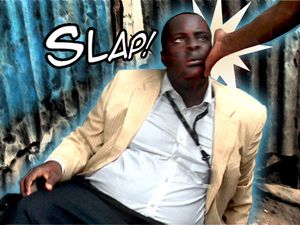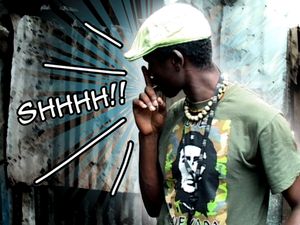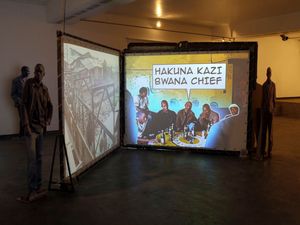Afropolis (Nairobi section)
2010
Afropolis_01_Production Image_2011_(c)Slum TV/King/Matathia/Essuman-2
Afropolis – Stadt, Medien, Kunst. Kairo, Lagos, Nairobi, Kinshasa, Johannesburg - Fiona Siegenthaler
Originally published in Savvy Magazine*, edition 01*
Curating is a practice that includes not only taking care of the art (curare = lat. to care for), but it also aims at caring for the exhibition visitors by giving them the opportunity of a special experience beyond the everyday routine. To curate is actually to create a setting in which art can be experienced. This task becomes particularly challenging when a team of curators sets out not only to show contemporary art from five major African cities, but to additionally provide for an actual (however forcibly limited) experience of the African metropolis itself. Afropolis, curated by social anthropologists Kerstin Pinther and Larissa Förster and artist Christian Hanussek, represents such an attempt as one of the first exhibition projects of this kind in central Europe – and it does so in a convincing way.
Their approach is both highly inclusive and risky. The newly opened Joest-Rautenstrauch Museum in Cologne offers a vast exhibition space that has been sectioned by movable walls, thus creating a number of individual exhibition spaces which are loosely connected to each other. In this spatial choreography, each of the African cities receives its section in which it is reflected in art works and documentation. But they also are connected among each other, so that you may, rather unknowingly, suddenly stumble from Cairo into Lagos and from there to Nairobi. The exhibition layout thus suggests that each African city in its individuality has something in common with the others – the notion of the African metropolis, Afropolis, its own way to function and its particular visual, auditory and physical presence.
The number and density of art works presented contributes to this experience: Photographs, installations, sculptures, paintings, but also a lot of video and text information reflect the city as a visual appearance and as a socially, politically, economically and culturally marked realm of exchange and transition in a permanent state of potential as well as decay. While, on the homepage, the curators attempt to draw a distinction between documentary sections and the art works, this clear delineation is slightly dissolved in the actual exhibition. The amplitude of the material on display, the non-linear path through the exhibition, and the intermingling of creatively produced documentary and art works that use documentary approaches level the distinction between the roles of art and documentation.
Information and documentary material thus claim the same degree of attention as the art presented. While this may be criticized – and it has been so by art critics – this combination can also be considered as a remarkably balanced and indeed successful one. Because informational parts as well as the art works interact with each other in such a setting, the exhibition creates something that may best be described as an introduction into visual and popular culture and practices in African metropolises.

Afropolis_01_Production Image_2011_(c)Slum TV/King/Matathia/Essuman-2
Surprisingly, and quite different to other exhibitions of this kind, Afropolis manages to deal with a rather small selection of photo artists. It also requires - like an adequate introduction into a real African city - a lot of time and patience from the viewer.
The exhibition, however, also induces critical questions – if purposefully or not. How to handle, for instance, a carefully painted part of a Matatu? Is it a singular artistic expression or does it reflect urbanity as a designed lifestyle? Is it a residue imported from Nairobi to Köln or is it a curiosity worth to be collected? Another question rising is: Why are there so many works dealing with the streets, the exterior of buildings and public space? Does urbanity really only take place in a built public environment, and how much do we leave out when we concentrate on the busy streets and not on what is happening within the buildings, in the homes, in the offices, schools, taverns and shops? In what relation do the visible surfaces of the city stand to the subjective experience of the tourist, the visiting researcher, the local artist and the local residents? While some art works deal with these questions, they are not necessarily reflected on a curatorial level. Another interesting question which could be more thoroughly thought about - mainly when urbanity is looked at through the lens of art works - is the role that art plays in the representation of cities, but also in terms of social as well as art historical traditions and visual cultures. For instance, some exhibited works are reminiscent of iconic artworks by other artists which had been circulating for about 20 years in the international art world. Does the utopian Tourist City by Pume Bylex, or Casualities made from beer cans by Kainebi Osahenye, stand in a tradition with the work of Bodys Isek Kingelez or El Anatsui? Are Bylex and Osahenye random figures in global or globalizing cities, or do they occupy a specific place in local or transnational art history?
Some questions are reflected and partly also answered in the exhibition catalogue which without exaggeration can be considered as the first relevant and visually rich publication in German language on contemporary African metropolises.
It includes contributions by significant theorists as well as texts by authors highly familiar with the diverse cities and their cultural history, mixed up with artist interviews and insights into popular media such as city-related cinema or literature history. With its German translation of one of AbdouMaliq Simone’s seminal essays, People as Infrastructure, the catalogue introduces an important field of research and discourse from the English-speaking world into German attention.

Afropolis_01_Production Image_2011_(c)Slum TV/King/Matathia/Essuman-3
To complete the array of visual, acoustic and scholarly approaches to the African city in this exhibition project, a rich program was set up with public lectures, artist conversations, film screenings, concerts, spoken word events and much more, thus contributing to the experience of a broad spectrum of what constitutes urban culture in African metropolises for a German audience.

Afropolis_01_Production Image_2011_(c)Slum TV/King/Matathia/Essuman-4
download text as PDF